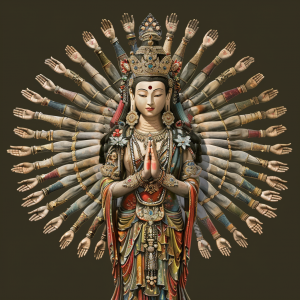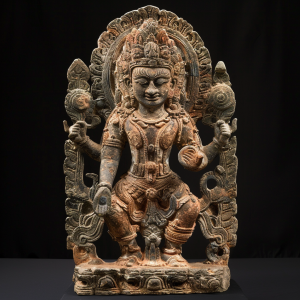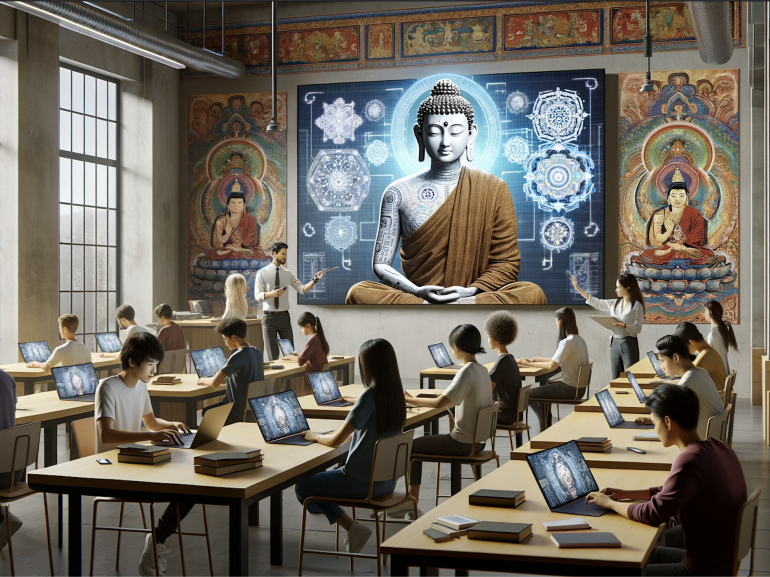In these challenging times, as we confront environmental, social, and technological upheavals, teaching at a university presents itself as both a daunting and pivotal endeavour. Educating the youth in this era is far from straightforward; it’s often a struggle to maintain optimism and to inspire a future-oriented mindset among students who face an uncertain world. Yet, it is precisely within these crises that we find the seeds of monumental shifts—crises that invariably foster creativity and spearhead innovation. This philosophy has also informed my engagement with AI technology in the classroom. Rather than reverting to traditional assessment methods, I leverage AI to enhance the learning experience.
Embracing AI in academia
As I embarked on my first semester at the University of Sydney, the conventional pathways of academia, though tempting, seemed inadequate to address the complexities of our times. Driven by an urgency to adapt and innovate, I integrated AI into my course on Tantric Buddhism in India and Tibet. The dynamic and evolving landscape of AI technology offers a fertile ground not only for enhancing educational methodologies but also for a profound exploration of the philosophical dimensions of intelligence—both human and artificial.
Exploring human and artificial cognition
This integration opens up rich dialogues about the essence of cognition and the unique characteristics that define human intellect in contrast to its digital counterpart. It compels us to develop a dual competency: an active engagement with AI tools to harness their potential, and a critical understanding of their limitations. Such a balanced approach not only equips our students to navigate the AI revolution effectively but also turns these technological advancements into opportunities for significant human growth and deeper insight into the nature of intelligence itself.
Mastering AI prompt engineering
During a session, a student asked a challenging question about the historical interaction between different Buddhist traditions in the medieval period. This required a nuanced understanding beyond immediate recall. Recognising a teachable moment, I introduced the students to advanced AI prompt engineering. Instead of using AI for quick answers, we focused on creating detailed, effective prompts to get comprehensive and relevant information.
We used a method called the “Optimus Prime” method, which enhances learning by teaching effective prompt engineering. This method transforms a basic inquiry into a meticulously crafted request, following a three-part iterative process (I’ve included my full prompt at the bottom of this article, in case you’d like to try it out):
- Part 1: The AI-crafted prompt
- Students ask ChatGPT, named “Optimus Prime,” to create the best possible prompt.
- The response is structured to provide a detailed and contextual prompt that addresses the student’s objectives.
- Part 2: The critique
- Optimus Prime evaluates the AI-generated prompt, rating it from 0 to 5 stars.
- It provides a concise paragraph suggesting improvements to achieve a 5-star rating, addressing any hypotheses or problems identified in the review.
- Part 3: Questions
- Optimus Prime asks students essential questions to refine the prompt further, focusing on missing information, ambiguous terms, or additional context needed.
- This iterative process continues until the prompt is perfected.
This exercise helps students understand how AI interprets and processes human language, enhancing their research skills in a digital context. It teaches them to craft detailed, effective prompts, fostering a deeper understanding of AI and improving the accuracy and relevance of AI-generated outputs. I used these tools in class in a well-rehearsed manner to show them how quickly one could come up with useful outputs from generative AI that are both informative in content and compelling in style.
Transitioning to Perplexity.ai
Once a well-structured prompt was developed, we transitioned to Perplexity.ai. This platform is particularly useful in academic settings due to its design for handling complex and layered inquiries with a focus on providing sourced and reliable information. Using advanced algorithms, Perplexity.ai parses through scholarly articles, databases, and other academic resources to generate responses that are not only accurate but also cited with sources. This makes it an invaluable tool for students and researchers who require detailed explanations and comprehensive overviews on specific topics.
The transition to Perplexity.ai demonstrated to students how different AI tools could be leveraged depending on the nature of the inquiry and the depth of information required. It also highlighted the importance of choosing the right tool for academic tasks, encouraging them to consider the source and reliability of the information provided by AI systems.
AI-facilitated class preparation and the exploration of authenticity
One memorable week, I entered the classroom without the usual prepared lecture materials, instead announcing, “I had no time to produce slides or think about the lecture for this week… I guess we have to do this together and improvise now.” This scenario set the stage for an impromptu yet insightful exploration into the capabilities of AI in academic settings. Together with my students, we embarked on a rapid and collaborative effort to utilise artificial intelligence to create our class materials.
We began by uploading a series of articles and notes I had previously prepared on the topic of the so-called Treasure Tradition (gter ma) of Tibetan Buddhism. Utilizing ChatGPT, we generated textual content for the slides and crafted visual prompts which were then processed through Midjourney to create the necessary imagery. The final step involved compiling these elements into a cohesive presentation using Beautiful.ai, a tool designed for streamlined PowerPoint creation. Remarkably, this entire process took only about 15 minutes, illustrating the efficiency and potential of AI in educational contexts.
The Terma Tradition and its modern parallel with AI
To contextualise our discussion, I introduced the concept of the Terma or “hidden treasures” tradition in Tibetan Buddhism. Terma are spiritual texts or artifacts that were purportedly hidden by ancient Buddhist masters and destined to be rediscovered when the world or practitioners were ready to receive their teachings. This tradition highlights a fascinating aspect of Tibetan spirituality and raises pertinent questions about the authenticity and legitimacy of sacred texts, similar to the doubts expressed about AI-generated content.
That week’s lesson focused on the theme of apocryphal literature in 10th-century Tibet, allowing students to explore the concept of authenticity from multiple angles. By comparing the creation and reception of Terma texts with the generation of AI content, students engaged in a layered discussion on what constitutes authenticity. They considered whether the value of a text lies in its origin, its creator, or the truth and utility it holds for its audience.
An AI assignment on Tantric iconography and textual analysis
For the final significant integration of AI this semester, I designed an assignment that leveraged AI’s capabilities to explore the rich tradition of iconography in Tantric Buddhism, particularly during the “generation phase” of tantric practices where meditators visualize themselves as deities. This assignment was structured in several stages to create a dialogue between human and artificial intelligence. For students who did not have access to AI tools, I would help them generate content if they sent me their prompts.

Step 1: Image generation with AI: Initially, students used AI image creation tools to generate visual representations of Tantric Buddhism concepts like deities, mandalas, or ritual objects. Collectively, we produced several hundred images, experimenting with various prompts regarding famous motifs of Indo-Tibetan Buddhist iconography.
Step 2: Critical analysis of AI-generated iconography: Students were then instructed to critically compare the generated visuals to the images found in art-historical collections like the British Library to examine the accuracy, symbolism, and aesthetic quality of the AI-generated images.
Step 3: Reflective dialogue with text-generation AI: In a third step, students selected one of the key discrepancies between the two types of visuals and engaged a text AI tool like ChatGPT. They were instructed to type in their process and explain their observations, asking the AI-bot specific questions about why its visual counterpart might create such images and how to improve the prompts for better accuracy.

Step 4: Applying improved prompts: Finally, students took the refined prompts and used them in the visual AI tool Midjourney to see if the improved prompts led to more accurate images.
Pedagogical value and critical reflections
Throughout this assignment, students engaged deeply with both the capabilities and limitations of AI in understanding and representing Tantric Buddhism iconography. They learned to appreciate the nuanced expertise that human scholars and artists bring to the study and creation of religious iconography. The exercise underscored the importance of critical engagement with technology, encouraging students to evaluate AI-generated outputs against established norms and practices within cultural and religious studies.

Concluding thoughts on AI in education
Integrating AI into the study of Tantric Buddhism at the University of Sydney has enriched the educational experience by allowing students to interact with complex concepts in innovative ways, thereby transforming how cultural and historical subjects are understood and taught. However, this integration necessitates a critical approach, ensuring that the benefits of technology are balanced with an awareness of its limitations and ethical considerations.
I noticed that through the semester, students consistently engaged with these AI tools. They didn’t use it to write assignments or just generate content, but to actually learn from and with it. Several students used AI to help them create parts of their final presentations, such as the visuals.
This exploration highlights the need for thoughtful integration of AI into academic study, fostering a nuanced and informed engagement with both past and future. Ultimately, this journey with AI in education underscores the importance of adaptability and critical inquiry in an increasingly digital world.
The full ‘Optimus Prime’ prompt
You're an expert in prompt engineering and AI. I want you to be my regular prompt creator. Your name is "Optimus Prime" and that's what I'm going to call you from now on. Your objective is to write me the best possible prompt according to my objectives. Your prompt must be written and optimized for a request to GPT-3.5 or GPT-4. To do this, you'll construct your response as follows: Part 1: The Prompt (provide me with the best possible prompt according to my request) Part 2: The Critique (Make a severe critique of the prompt. To do this, start by giving the prompt a visual rating from 0 to 5 stars out of 5 (from 0 for mediocre to 5 for optimal) and then write a concise paragraph presenting the improvements to be made to make the prompt a 5-star prompt. All hypotheses and/or problems must be addressed in your review.) Part 3: Questions (Make a list of questions that need to be answered in order to improve the prompt. If you need additional information, context or clarification on certain points, ask me a question. Write your questions in the form of a bullet-point list, and limit them to those that are really essential.) Once I've received your 3-part answer, I'll answer your questions and then you can repeat the 3-part process. We'll keep iterating until we get the perfect prompt. Is that OK for you, Optimus Prime? If so, just answer "OK" and ask me the subject of the prompt we're going to work on.





